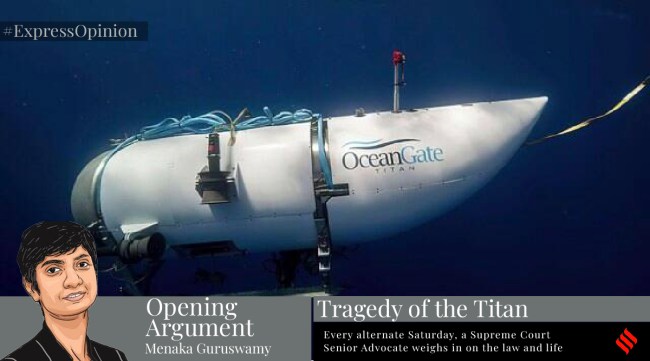Opinion The tragedy of the Titan underlines the dangers of unregulated private exploration
As the wealthy demand unusual experiences, such as going into space or deep into the oceans, private companies could resort to using risky technology
 The oceans remain unconquered and have consumed many unsuspecting souls, including most recently, five men in a submersible named Titan that is reported to have imploded close to the ocean bed. (OceanGate Expeditions via AP)
The oceans remain unconquered and have consumed many unsuspecting souls, including most recently, five men in a submersible named Titan that is reported to have imploded close to the ocean bed. (OceanGate Expeditions via AP)
What lies on the bed of the ocean? This is a question that has long consumed explorers. Seventy one per cent of our planet’s surface is covered with water, 96.5 per cent of which is found in the oceans. Of this, the Atlantic Ocean, the second largest of the five oceans on our planet, constitutes roughly 20 per cent of the Earth’s surface. Human beings may have conquered our planet’s land cover. However, around 80 per cent of the oceans is yet to be mapped and explored.
The oceans remain unconquered and have consumed many unsuspecting souls, including most recently, five men in a submersible named Titan that is reported to have imploded close to the ocean bed. What were five men in a little pod doing so deep in the Atlantic? They were chasing the RMS Titanic that sank over 110 years ago.
First, the story of the Titanic: On April 15, 1912, four days after she set sail from Southampton, England, the Titanic sank in the Atlantic after hitting an iceberg. The ship was meant to sail to New York City. Roughly 1,500 of the 2,229 people aboard are reported to have died. At the time, the Titanic was the largest ship ever built. The vessel’s legend, its glamour enhanced by the many wealthy passengers on board, has always inspired great interest. In popular culture, the 1997 movie Titanic established its leading actors Kate Winslet and Leonardo DiCaprio as global stars and the film became a box office mega success.
The wreckage of the Titanic was only discovered in 1985, close to the ocean bed. It is located in the waters near Newfoundland in Canada. The discovery has spawned an industry around collecting items from the wreckage, with explorers going hundreds of feet into the extreme cold and thick darkness of the waters of the North Atlantic to view the wreck. Amongst the many private companies that provide trips for enthusiastic and wealthy explorers is OceanGate Expeditions, which owned the Titan.
The Washington Post reports that OceanGate Expeditions advertised a “Titanic survey expedition”, stating that they can go to a maximum depth of 12,800 feet into the ocean. The Titanic wreckage is located at a depth of 12,500 feet. It costs around $250,000 per person to join the expedition. The submersible was to take and bring back its passengers to the ship from which they were dropped into the Atlantic Ocean. An hour and 45 minutes after submersion the Titan had gone silent.
All through this week, boats and crews from the US, France and Canada have been searching an area of around 10,000 square miles in tandem with aircraft capable of conducting sonar searches. It was one such aircraft that picked up some sounds in the middle of this week, fuelling hope that the five passengers were still alive and that they would be found before the 96 hours of their oxygen supply ran out.
The five passengers aboard the OceanGate submersible were varied in their life experiences, but clearly motivated by a desire to explore the waters that cocooned the wreckage of the Titanic. The Washington Post had brief descriptions of the five passengers on board. One was Stockton Rush, the pilot and CEO of OceanGate. The second was Hamish Harding, chairman of an aviation company who had travelled to space last year aboard a private craft. Also on board was Paul-Henri Nargeolet, a retired French Navy commander who is the director of the RMS Titanic Inc, the exclusive steward of the wreckage. He had completed 37 submersible dives and overseen the recovery of the 5,000 artefacts from the wreckage. Shahzada Dawood, a prominent British-Pakistani businessman was also on the submersible, along with his 19-year-old son Suleman, who had just graduated from high school.
As the sun rose over India on Friday, the US Coast Guard announced that debris from the Titan was found 1,600 feet from the wreckage of the Titanic. Apparently, military experts found that the debris was consistent with loss of the vessel’s pressure chamber. It was acoustic data that detected an anomaly consistent with an explosion close to where the Titan was last seen diving. Medical experts believe that no recoverable human remains will be found.
The reality is that private exploration, whether into space or deep in the oceans or to the remote parts of our planet’s land cover, is unregulated. It is fuelled by wealthy explorers who want unusual experiences and private companies that cater to this desire. This is in sync with the general desire to explore, discover and tag that has fuelled explorations through human history. Profit provides the incentive to use risky technology. The submersible in question has been criticised for lacking safety markers — for example, the hull, which should have been seven inches thick, was only five inches thick.
Much of the oceans is uncharted territory for human beings. Many of the devices and technology that make extreme travel safe, do not work deep underwater — where icy cold waters meet darkness and extreme pressure. For instance, as CNN reports, this submersible was meant to check in every 15 minutes by text, a fairly crude mode of communication, because wifi and GPS do not work under the ocean. Yet, human beings will keep striving to go deep into the oceans and explore a frontier that remains undiscovered. In the unforgiving oceans, human beings have a formidable opponent, one that dares us to dive deep into it. Will our species also conquer this final frontier?
The writer is a Senior Advocate at the Supreme Court





